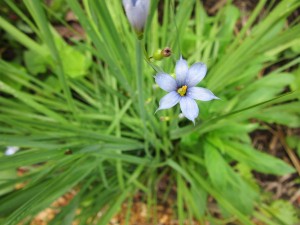Blue-eyed Grass – June 2016 Wildflower of the Month
 Not a grass, but a member of the Iris Family, this little blue flower has a yellow eye; each of the six petal-like parts has a bristle tip. Leaves are narrow, branching and grasslike, 6-18 inches tall. Flower color ranges from pale blue to deep blue-violet, the flower size from ¼” to ¾” wide. Blooming from May through June, small round fruits are produced through July.
Not a grass, but a member of the Iris Family, this little blue flower has a yellow eye; each of the six petal-like parts has a bristle tip. Leaves are narrow, branching and grasslike, 6-18 inches tall. Flower color ranges from pale blue to deep blue-violet, the flower size from ¼” to ¾” wide. Blooming from May through June, small round fruits are produced through July.
This perennial is common throughout Virginia, growing in meadows, ditches and damp woods. Two other similar perennials are in the Coastal Plain; the stems of S. atlanticum are more narrow, and S. mucronatum has unbranched stems. Annual Blue-eyed grass S. rosulatum is not native; the petals are lighter, and a conspicuous dark ring surrounds the center. This introduced species is common in the Gulf coastal states, and is spreading northward, growing in fields and disturbed ground.
Blue-eyed grass does best in full sun to partial shade, preferring good, moist, well-drained soil. After the flowers fade, clumps of the narrow leaves are an attractive groundcover throughout the summer and into fall. The plants look great in a rock garden or along a border and can naturalize in the lawn. Propagation is by seed or division; they will self-seed, but not aggressively.
The genus name is Greek, sys for “pig” and rynchus for “snout,” referring to “pig snout” as pigs searched for the roots. Native Americans used the plant for medical purposes.
By Helen Hamilton, past-president of the John Clayton Chapter, VNPS
Photo: Blue-eyed Grass (Sisyrinchium angustifolium) taken by Helen Hamilton
